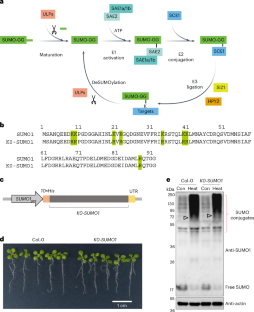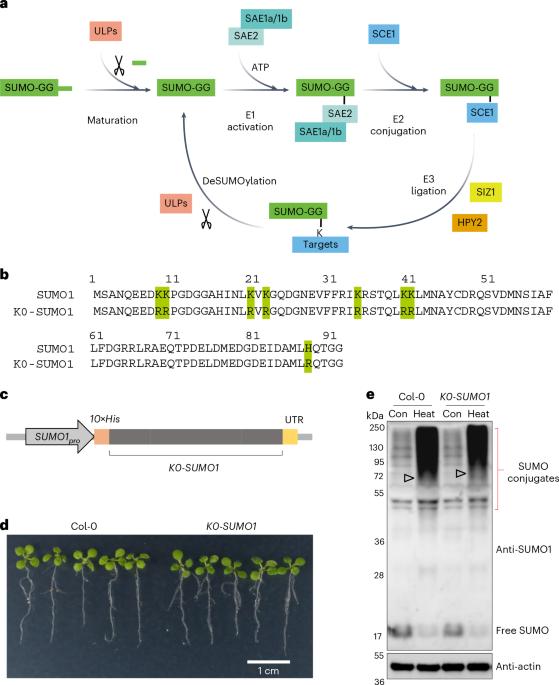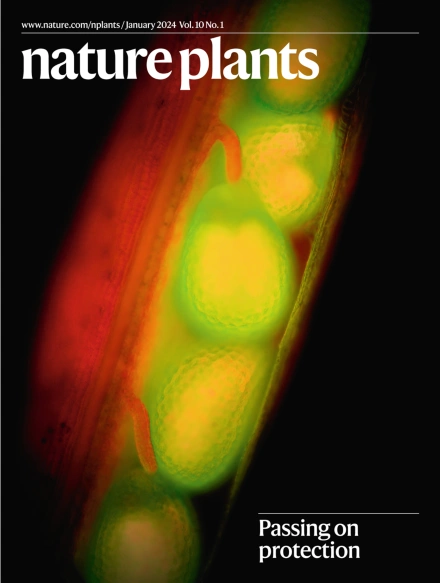Highly sensitive site-specific SUMOylation proteomics in Arabidopsis
IF 15.8
1区 生物学
Q1 PLANT SCIENCES
引用次数: 0
Abstract
SUMOylation—the attachment of a small ubiquitin-like modifier (SUMO) to target proteins—plays roles in controlling plant growth, nutrient signalling and stress responses. SUMOylation studies in plants are scarce because identifying SUMOylated proteins and their sites is challenging. To date, only around 80 SUMOylation sites have been identified. Here we introduce lysine-null SUMO1 into the Arabidopsis sumo1 sumo2 mutant and establish a two-step lysine-null SUMO enrichment method. We identified a site-specific SUMOylome comprising over 2,200 SUMOylation sites from 1,300 putative acceptors that function in numerous nuclear processes. SUMOylation marks occur on several motifs, differing from the canonical ψKxE motif in distant eukaryotes. Quantitative comparisons demonstrate that SUMOylation predominantly enhances the stability of SUMO1 acceptors. Our study delivers a highly sensitive and efficient method for site-specific SUMOylome studies and provides a comprehensive catalogue of Arabidopsis SUMOylation, serving as a valuable resource with which to further explore how SUMOylation regulates protein function. This study establishes an efficient method for site-specific SUMOylation proteomics, achieving a comprehensive SUMOylome comprising over 2,200 SUMOylation sites, which could serve as a useful tool and valuable resource for future research in plants.


拟南芥中高灵敏度的特定位点 SUMOylation 蛋白质组学
SUMO酰化--一种类似泛素的小修饰物(SUMO)附着在目标蛋白质上--在控制植物生长、营养信号传导和胁迫反应中发挥作用。植物中的 SUMO 化研究很少,因为鉴定 SUMO 化蛋白及其位点具有挑战性。迄今为止,只确定了大约 80 个 SUMOylation 位点。在这里,我们将赖氨酸缺失的 SUMO1 引入拟南芥 sumo1 sumo2 突变体,并建立了一种两步赖氨酸缺失 SUMO 富集方法。我们确定了一个位点特异性 SUMOylome,其中包括来自 1300 个推定接受者的 2200 多个 SUMO 化位点,这些接受者在许多核过程中发挥作用。SUMO酰化标记出现在多个基序上,不同于远缘真核生物的标准ψKxE基序。定量比较表明,SUMOylation 主要增强 SUMO1 受体的稳定性。我们的研究为特定位点的 SUMOylome 研究提供了一种高灵敏度和高效率的方法,并提供了拟南芥 SUMOylation 的全面目录,为进一步探索 SUMOylation 如何调控蛋白质功能提供了宝贵的资源。
本文章由计算机程序翻译,如有差异,请以英文原文为准。
求助全文
约1分钟内获得全文
求助全文
来源期刊

Nature Plants
PLANT SCIENCES-
CiteScore
25.30
自引率
2.20%
发文量
196
期刊介绍:
Nature Plants is an online-only, monthly journal publishing the best research on plants — from their evolution, development, metabolism and environmental interactions to their societal significance.
 求助内容:
求助内容: 应助结果提醒方式:
应助结果提醒方式:


